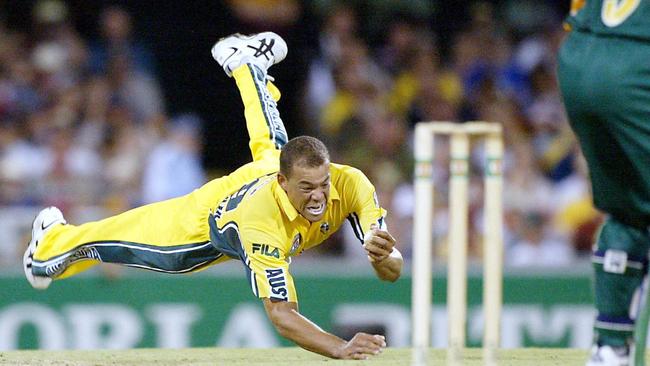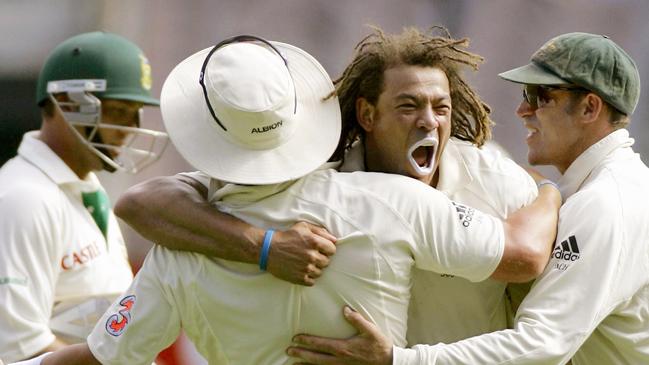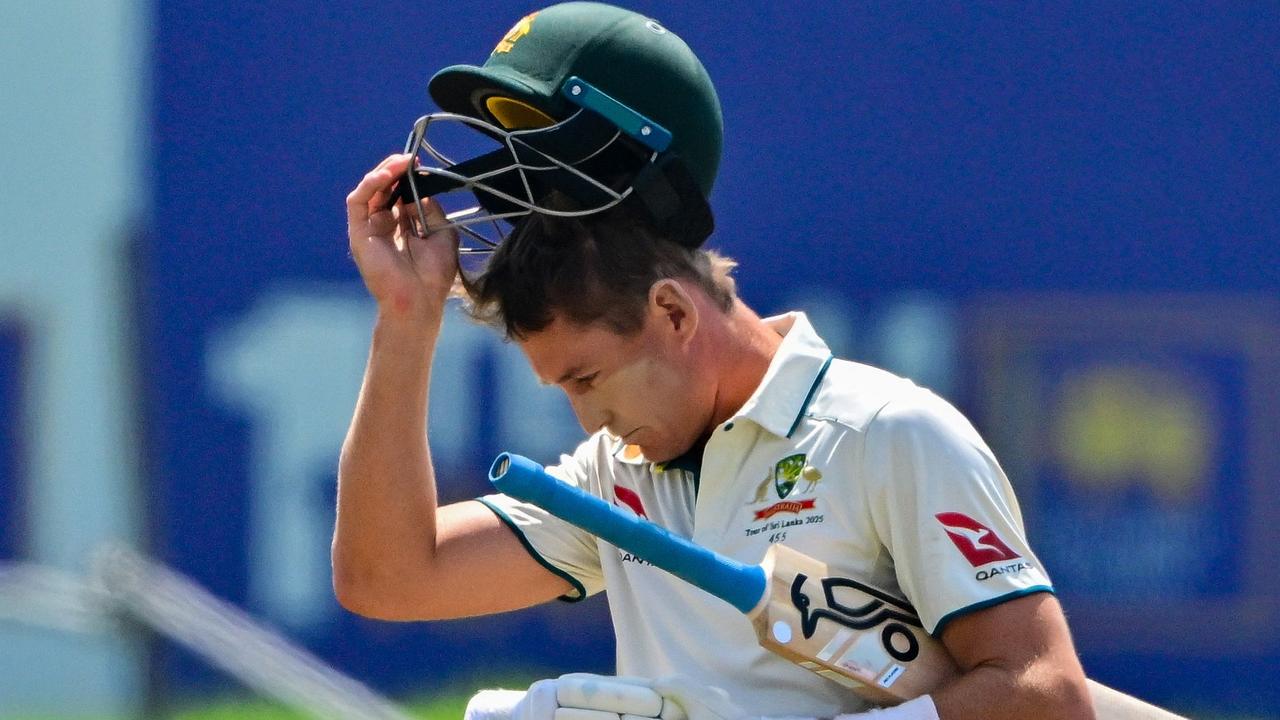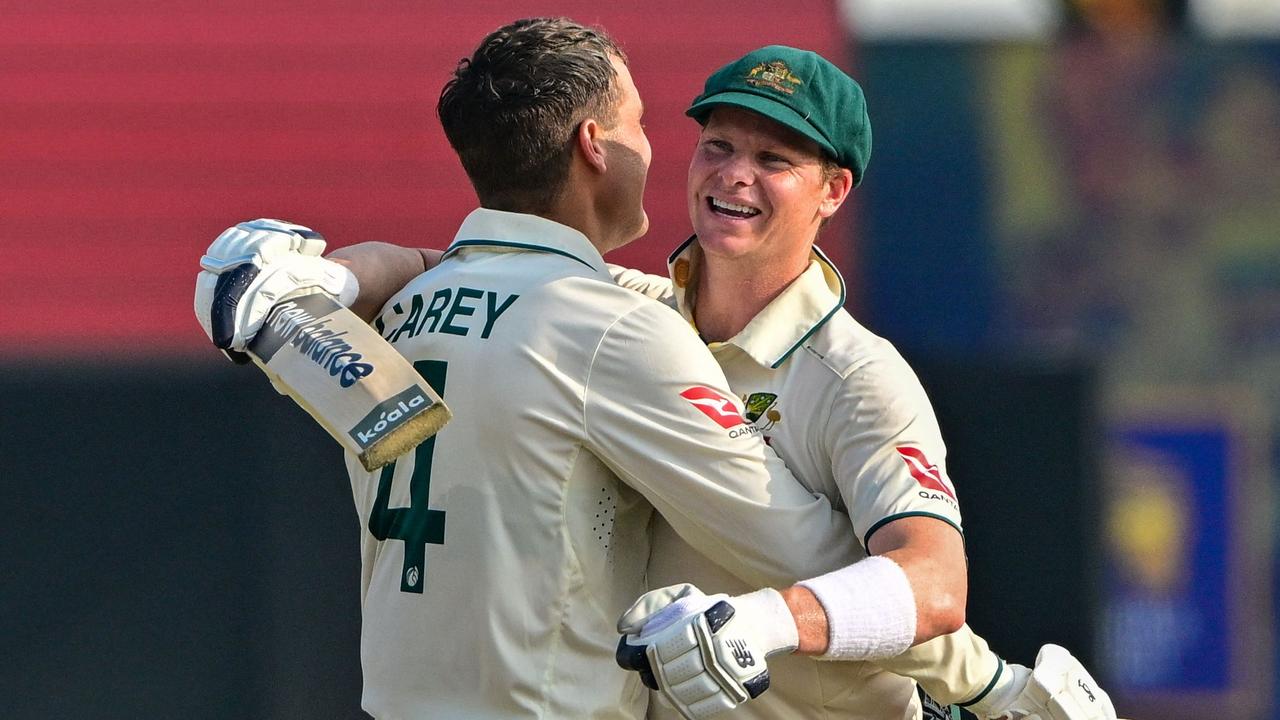Joy of Roy was something to behold
Andrew Symonds was a precociously and uniquely talented cricketer who sometimes felt he gave while teammates took.
It was the joy of Roy that took you by surprise. The unbridled joy of a five-year-old leaping into his father’s arms after a long separation or that’s what he looked like as he launched into an embrace with his dearest friend Matthew Hayden on that crowded day against England at the MCG in 2006-07.
For a minute we witnessed a man’s man celebrate like a child. For a moment we understood the relief.
His drought had broken in the most spectacular manner. His moment at hand.
Back in the Test side but on the brink of being dropped again if he could not make it work, he had just 314 runs from 17 first class innings to that point.
Australia were 5-84 when Symonds walked out to bat with a “nagging little voice in my head telling me that this surely be my last chance”.
The pressure to perform in front of the packed stadium must have been immense. His mother, his father, his grandfather, his brother and sister were in the stands. His best friend and soulmate, Hayden, waiting for him in the middle.
Together they’d caught more fish than most could eat in a lifetime, they’d swum for hours against a strong current with a struggling friend after their boat sank in the ocean one day, they’d spent hours as younger men in the nets honing each other’s game – that paid off in the 1997-98 season. They’d painted Symond’s face with pig’s blood when he killed his first boar.
In the early years in state cricket Hayden had been worried his mate was on the outer and had pushed his case before selectors and coaches. He’d then pushed him to go that extra yard at training.

In the middle of the MCG Symonds eased into his work his way. He clattered two fours on the up through the off-side off Matthew Hoggard and started to find his range. Having promised Hayden he would not go silly when the part-timers were introduced he promptly lifted Paul Collingwood back over his head to bring up his maiden Test century with a six.
A champagne cork left the bottle. He waved his arms in the air and ran toward his partner.
Hayden almost buckled under the exuberance of Symond’s bear hug.
That night he asked the opener why he had a welt on his forehead. One Queenslander explained to the other that it was from the impact of the celebrations.
Roy’s pure joy was something to behold and in it there was a hint of just how hard this all was for him.
Of all the things a batsman can be, being the X-factor matchwinner must be the hardest. The grafters and the elegant professionals by comparison exist in something of a comfort zone to the batter who is essentially the joker in the pack. Sometimes trump card, more often than not the high roller who goes broke early.
At times this player will test the patience of the selectors, teammates and fans as they ride the highs and then trawl through the troughs. It takes enormous resilience to be that player and you suspect it took a fair toll on Symonds.

He was precociously and uniquely talented.
As a 20-year-old he’d hit 16 sixes on his way to 254 for Gloucestershire against Glamorgan at Abergavenny. The measure of feat is apparent in the fact it took a quarter of a century and somebody as extraordinary as Ben Stokes to break that County record a few weeks back.
“Hitting balls out of the ground is a magical sensation – there’s a split second when you realise the ball’s gone the journey and you are not going to get out,” Symonds wrote in his first book.
Born in England of West Indian heritage he was adopted by a white English couple who later migrated to Australia. His father took a job at Geelong Grammar, but after a few years the family shifted to Charters Towers and Roy’s love of the bush took root. It is fair to say those roots ran deep until the end.
In 1997-98 the Australian Cricket Board (now Cricket Australia) offered Symonds a developmental contract.
“I’d well and truly embraced the North Queensland lifestyle by this stage” he admitted in his book Roy Going for Broke and so didn’t think twice about driving to Queensland Cricket in his four wheel drive ute with his dog Mac in the back, an Akubra on his head and a blue singlet. A pair of Parramatta Rugby League shorts and his best shorts completed the picture. He may, he concedes, also have been a little aromatic as he’d just been putting out some crab pots and “probably had the whiff of bait on me as well”.

The Queensland cricket staff didn’t bat an eye-lid, they knew Roy, chief executive Graham ‘Dicko’ Dickson probably grimaced but was not too put out, but Melbourne lawyer and Cricket Australia chief executive Malcolm Speed, whose presence was unexpected, was a little taken back.
“Okay, there goes ten grand – better keep an eye on that one for me,” Speed told Dickson after Symonds signed the contract.
It was partly this larrikin charm which made him the marketing face of the Australian cricket team for a while. His zinc creamed lips and dreadlocked hair were used to promote every product the game needed to flog.
Symonds the sportsman was a superman. Broad of chest and intimidatingly tall, he and his mate Hayden had the ability to turn the tables and intimidate bowlers with their aggression. Roy once signed a shirt for Sachin Tendulkar which was on the wall of the Indian’s Mumbai restaurant. On it he’d written “the man we all want to be”. Tendulkar had given Symonds one in return on which he wrote “we all want to hit the ball as hard as you”.
Symonds was part of a glorious era of Australian fielding too. He, Ricky Ponting and Michael Clarke were like predators hunting their prey when they roamed the inner circle in that era. He was a trundler of some note too, able to swing the ball both ways when bowling seam and a handy spinner.
He knew he was adopted but always maintained he had no interest in learning anything about his biological parents. “This attitude probably won’t get me a start on Oprah or Dr Phil but I think I’ll survive just the same.”
Perhaps it was the bushman in him, but he bristled at the demands of cricket, often buckled under the pressures of the game and let himself down through ill disciplined acts and found the boundaries hard to respect.
In 2002 he rang Brisbane Broncoes coach Wayne Bennett and suggested he be given a chance to prove himself as a rugby league player. He was built for it and as anybody who saw him dispatch a streaker during that one day match knows, he was enormously powerful.
“I didn’t feel comfortable in the Australian team environment: it was a ‘survival of the fittest’ culture and while I understood this, I enjoy other people’s success and have always prided myself on being able to help them achieve it. I don’t care if it’s not always reciprocated, that’s not why I do it. But I did feel at that point that I was doing a lot of giving, and that plenty of people were doing the taking,” he wrote in Roy: Going for Broke.

Symonds was tried too by his role as the big-hitting matchwinner. The rare rewards didn’t compensate for the torture of the many times it did not come off. “I’d tried being aggressive and that hadn’t worked; I’d tried grinding out the innings, and that hadn’t worked either, so I didn’t really think I had a hope in hell”.
Symonds was caught between two worlds in a cultural and cricketing sense. He wasn’t a city boy or an attention seeker, but his day job insisted he be things he was not. Selectors, coaches and critics insisted at different times celebrated when he was bold and it paid off but like him could grow frustrated when it did not.
Fame did not sit well with him.
At one point, at the height of his popularity, he asked Cricket Australia to remove the marketing element of his contract so he could just play and not have to do any of the other things incumbent on a high profile sportsman.
Hayden, Queensland and Australian coach John Buchanan and then Australian skipper Ricky Ponting had more faith in Symonds than possibly he had in himself.
Ponting always pushed for his selection and though the all-rounder was out of form he got him included in the 2003 World Cup. He walked to the middle at Wanderers with an ODI average of 23.8 and a best of 68 and Australia was in trouble against a strong Pakistan bowling side. but he batted boldly. Late in the innings he experienced the deep pleasure of hitting Waqar Younis and Wasim Akram back over their heads for six. He’s scored 143no when he most needed to. “It was like I’d been ordering drinks at the Last-Chance Saloon on credit and then bang! I’d won the lottery!”.
With Ponting’s backing he’d go on to score that 156 at the MCG against England in 2006-07 and then 162no against India in the blighted Test series of the following season.
When Harbhajan Singh first called Symonds a monkey the all-rounder dealt with it his way and wandered to the Indian’s change room door to confront his opponent. With team manager by his side he indicated his displeasure at the term and asked that it not be used again.
The matter was taken out of his hands when the incident was repeated in Sydney. The Australian was to become disillusioned over the way India, Cricket Australia and the game responded to the incident. A NZ judge appointed to hear Harbhajan’s appeal against a ban went out of his way to criticise Symonds approach to the game, Cricket Australia conspired with the BCCI to reach a compromise and in doing so the player felt let down.
He had his darkness all the while but at times after this it consumed him.
“I started to drink heavily as a result of it and my life was starting to dissolve around me,” Symonds told Mark Howard recently in the podcast Howie Games.
“I felt the pressure and the weight of dragging those mates of mine into the cauldron of this cesspit that should never have got to this sort of point where we felt guilty.
“I wasn’t particularly bothered on how he got punished, that was nearly irrelevant to me. I wasn’t thinking about that, I was thinking about what I was going through and what I’d put the other boys through.

“That (the punishment) was neither here nor there with me, it was the weight and responsibility of what we’d all been dragged into.”
The treatment of Symonds sat poorly with Ponting.
“The worst of it all was the impact it had on Symmo,” he wrote in At the Close of Play. “In a lot of ways Symmo was gone from this moment on and it still makes me angry.”
Better, however, to remember the talent, not its loss or mistreatment.
Ponting said of that innings against Pakistan early in the 2003 World Cup that it gave the side the belief it needed to go on and win despite losing Shane Warne to a drug ban.
“I reckon some of us might have been secretly wondering if our chances of winning the Cup had left with Warnie, but no one was thinking that way now,” he wrote at the time.
It’s been a heartbreaking time for men like Ponting and Hayden who have lost their mentor Rod Marsh and then mates Warne and Symonds in quick succession.
Hayden and his wife Kellie were extremely close to the big man and loved him like family. The opening batsman was best placed to define that quality in Symonds that made him so special to those few who were permitted into his life.
Hayden wrote a chapter on him in his book Standing My Ground. He wrote of an “observant and thoughtful man” to whom children gravitated. A pig hunter who also had a “gentle, quiet side”. A teammate who had a “roll up your sleeves, she’ll be right mate” approach. One you couldn’t “bullshit”. One who ribbed Michael Clarke that he might be better off worrying less about his hair and more about his batting and one who stood up and announced he was just about finished with the game when Shane Watson lit a scented candle in the dressing room.
“I see Symo as a trailblazer for the international career players may have in the future _ shorter than we’re used to seeing, but very intense,,” Hayden wrote. “He was the greatest fieldsman the game has seen, and one of its most entertaining players.
“I’m proud to call him friend.”
It was short, it was intense, but the joy of Roy was something to behold.


